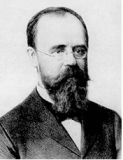 The website is in construction. New files will be uploaded as soon as they are available.
The website is in construction. New files will be uploaded as soon as they are available.
EMANUEL CZUBER
Prague 1851 - Gnigl 1925

- Brief scientific biography
- His commitment to Education
- Primary bibliography
- Essential secondary bibliography
Brief scientific biography
Emanuel Czuber was born in Prague in 1851. He graduated from the Realschule, a German secondary school, in 1869 and continued his studies at the German Technical University at Prague. Here he took an active role in the Association for Free Lectures on Mathematics: the student association which will become the Union of Czech Mathematicians and Physicists.In spite of still being a student, Czuber became an assistant to Karel Koristka from 1872 to 1875 and in 1976 he obtained the right to lecture with a thesis on practical geometry (geodesy) submitted to the Technical University of Prague.
From 1875 to 1886 he taught at the Second German Realschule in Prague and in 1886 he was appointed ordinary professor at the German Technical University in Brno, becoming Rector of that university in 1890-91.
After this year he was appointed ordinary professor at the Technical University in Vienna, becoming Rector in 1894-5, and holding the position of professor at the same University of Vienna until he retired in 1919.
In 1909 he became related to the Austrian royal family, since his daughter Berta married the younger brother of Franz Ferdinand d'Este, the successor to Austrian throne.
Czuber was a leading figure in probability theory. According to J. J. O'Connor and E. F. Robertson Czuber "wrote the first papers with original results on the probability theory in the Czech region. A large part of his studies, however, was devoted to questions concerning actuarial mathematics." (O'CONNOR, ROBERTSON 2005).
He studied the fundamentals of probability as far as related areas and applications such as the theory of errors. In this field he contributed in 1900 to the Encyklopädie der mathematischen Wissenschaften and wrote several books in German such as Theorie der Beobachtungsfehler (1891), Die Entwicklung der Wahrschinlichkeitstheorie und ihre Anwendungen (1898), Die Wahrscheinlichkeitsrechnung und ihre Anwendungen auf Fehlerausgleichung. Statistik und Lebensversicherung (first edition 1903, second edition 1908, reprinted 1968), Die statistische Forschungsmethoden (1921), Die philosophischen Grundlagen der Wahrschinlichkeitsrechnung (1923), and Mathematische Bevölkerungstheorie (1923).
He died in Gnigl in Austria on 22 August 1925.
His commitment to Education
Czuber's interest in teaching is already shown by the textbooks he wrote before the foundation of ICMI: Lehrbuch über Differential- und Integralrechnung (1898) and Einführung in die höhere Mathematik (1909). He also translated a textbook Calcul des probabilités, which had been written by Franz A. Meyer.From its foundation Czuber had been member of ICMI, of which he firmly led as president the Austrian Sub-commission (KLEIN, FEHR 1910, 127). In this sense he took an active part in the development of a report about The teaching of mathematics in the principal kind of school structures. During the first meeting of the ICMI Central Committee at Basel on 28 December 1909 the Austrian section presented the first results of this study: three booklets introduced by an article of Czuber himself had already been published as supplements of the Zeitschrift für das Realschulwesen and, within the works announced for future publication, there was a study on polytechnic schools developed by Czuber himself and E. Müller (FEHR 1910, 361).
As one of the directors of the Zeitschrift für das Realschulwesen Czuber enlarged the collaborations of this review, opening to mathematicians.
He was member of the ICMI Central Committee from 1912 until the Sixth International Congress of 1920 in Strasburg.
He also took part in the "Comité de patronage" of L'Enseignement mathématique.
Czuber has always shown a great interest in scientific teaching in secondary school. During the Paris Congress of 1914 Czuber chaired the session on the teaching of mathematics in the schools for engineers on 3 April 1914 and the session of 4 April dedicated to the discussion on the ICMI inquiries about "the results obtained by introducing the differential and integral calculus in the superior classes of secondary teaching and On the place and role of mathematics in the technical teaching" (FEHR 1914, 171-172). He was personally involved in this second inquiry, taking part as well in the discussion following P. Staeckel's general report (FEHR 1920, 315).
Primary bibliography
E. CZUBER 1898, Lehrbuch über Differential- und Integralrechnung,Leipzig, B. G. Teubner
E. CZUBER 1909, Einführung in die höhere Mathematik, Leipzig, B. G. Teubner
Essential secondary bibliography
F. KLEIN, H. FEHR 1910, Commission internationale de l'enseignement mathématique, Circulaire n. 2, L'Enseignement mathématique, 12, 124-139
H. FEHR 1910, Compte rendu des séances de la commission et des conferences sur l'enseignement scientifique et sur l'enseignement technique moyen, L'Enseignement mathématique, 12, 353-415
H. FEHR 1914, Compte rendu de la conférence internationale de l'enseignement mathématique, Paris 1-4 Avril 1914, L'Enseignement mathématique, 16, 165-177
H. FEHR 1920, La Commission internationale de l'enseignement mathématique de 1908 à 1920, L'Enseignement mathématique, 21, 305-318
J.J. O'CONNOR, E.F. ROBERTSON 2005, Emanuel Czuber:
http://turnbull.mcs.st-and.ac.uk/~history/Biographies/Czuber.html
E. DOLEZA 1928, Emanuel Czuber, Jahresbericht der Deutschen Mathematiker-Vereinigung, 37, 287-297
J. RADON 1951, Emanuel Czuber zum Gedächtnis, Nachrichten der Oesterreichischen Mathematischen Gesellschaft, 5, 13
Author
Michela Malpangotto
Observatoire de Paris - SYRTE
michela.malpangotto@obspm.fr
